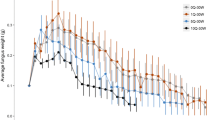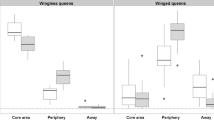Abstract
In many colonies of social insects, the workers compete with each other and with the queen over the production of the colony’s males. In some species of social bees and wasps with annual societies, this intra-colony conflict even results in matricide—the killing of the colony’s irreplaceable queen by a daughter worker. In colonies with low effective paternity and high worker-worker relatedness, workers value worker-laid males more than queen-laid males, and thus may benefit from queen killing. Workers gain by eliminating the queen because she is a competing source of male eggs and actively inhibits worker reproduction through policing. However, matricide may be costly to workers if it reduces the production of valuable new queens and workers. Here, I test a theoretical prediction regarding the timing of matricide in a wasp, Dolichovespula arenaria, recently shown to have facultative matricide based on intra-colony relatedness. Using analyses of collected, mature colonies and a surgical manipulation preventing queens from laying female eggs, I show that workers do not preferentially kill queens who are only producing male eggs. Instead, workers sometimes kill queens laying valuable females, suggesting a high cost of matricide. Although matricide is common and typically occurs only in low-paternity colonies, it seems that workers sometimes pay substantial costs in this expression of conflict over male parentage.



Similar content being viewed by others
References
Akre RD, Myhre EA (1992) Nesting biology and behavior of the Baldfaced hornet, Dolichovespula maculata (L.) (hymenoptera: Vespidae) in the Pacific northwest. Melanderia 48:1–33
Akre RD, Myhre EA (1994) Nesting biology of Dolichovespula norvegicoides (hymenoptera, Vespidae). Entomol News 105:39–46
Akre RD, Greene A, MacDonald JF, et al (1980) The yellowjackets of America North of Mexico. United States Department of Agriculture Washington, DC
Archer ME (2006) Taxonomy, distribution and nesting biology of species of the genus Dolichovespula (hymenoptera, Vespidae). Entomol Sci 9:281–293. doi:10.1111/j.1479-8298.2006.00174.x
Beekman M, Ratnieks FLW (2003) Power over reproduction in social hymenoptera. Philos Trans R Soc Lond B 358:1741–1753. doi:10.1098/rstb.2002.1262
Bloch G (1999) Regulation of queen-worker conflict in bumble-bee (Bombus terrestris) colonies. Proc R Soc Lond B 266:2465–2469. doi:10.1098/rspb.1999.0947
Bloch G, Hefetz A (1999) Regulation of reproduction by dominant workers in bumblebee (Bombus terrestris) queenright colonies. 45:125–135. doi: 10.1007/s002650050546
Bonckaert W, Vuerinckx K, Billen J, et al (2008) Worker policing in the German wasp Vespula germanica. 19:272–278
Bonckaert W, Tofilski A, Nascimento FS, et al (2011a) Co-occurrence of three types of egg policing in the Norwegian wasp Dolichovespula norwegica. 65:633–640
Bonckaert W, Van Zweden JS, d’Ettorre P, et al. (2011b) Colony stage and not facultative policing explains pattern of worker reproduction in the Saxon wasp. Mol Ecol 20:3455–3468. doi:10.1111/j.1365-294X.2011.05200.x
Boomsma JJ, Grafen A (1990) Intraspecific variation in ant sex ratios and the Trivers-hare hypothesis. Evolution 44:1026–1034. doi:10.2307/2409564
Boomsma JJ, Grafen A (1991) Colony-level sex ratio selection in the eusocial Hymenoptera. J Evol Biol 4:383–407. doi:10.1046/j.1420-9101.1991.4030383.x
Boomsma JJ, Ratnieks FLW (1996) Paternity in eusocial Hymenoptera. Philos Trans R Soc B 351:947–975. doi:10.1098/rstb.1996.0087
Bourke AFG (1994) Worker matricide in social bees and wasps. J Theor Biol 167:283–292. doi:10.1006/jtbi.1994.1070
Bourke AFG (2005) Genetics, relatedness and social behaviour in insect societies. In: Fellowes M, Holloway G, Rolff J (eds) Insect evolutionary ecology. CABI, Cambridge, pp. 1–30
Bourke AFG, Ratnieks FLW (2001) Kin-selected conflict in the bumble-bee Bombus terrestris (Hymenoptera: Apidae). Proc R Soc Lond B 268:347–355. doi:10.1098/rspb.2000.1381
Cole LR (1981) A visible sign of a fertilization action during oviposition by an ichneumonid wasp, Itoplectis maculator. Anim Behav 29:299–300. doi:10.1016/S0003-3472(81)80178-9
d’Ettorre P, Heinze J, Ratnieks FLW (2004) Worker policing by egg eating in the ponerine ant Pachycondyla inversa. Proc R Soc Lond B 271:1427–1434. doi:10.1098/rspb.2004.2742
Daly D, Archer ME, Watts PC, et al. (2002) Polymorphic microsatellite loci for eusocial wasps (Hymenoptera: Vespidae). Mol Ecol Notes 2:273–275. doi:10.1046/j.1471-8286.2002.00220.x-i2
Duchateau MJ, Velthuis H (1988) Development and reproductive strategies in Bombus terrestris colonies. Behaviour 107:186–207. doi:10.1163/156853988X00340
Duchateau MJ, Velthuis HH, Boomsma JJ (2004) Sex ratio variation in the bumblebee Bombus terrestris. 15:71–82. doi: 10.1093/beheco/arg087
Edwards R (1980) Social wasps: their biology and control. Rentokil Press, London
Foster KR, Ratnieks FLW (2001a) Convergent evolution of worker policing by egg eating in the honeybee and common wasp. Proc R Soc Lond B 268:169–174
Foster KR, Ratnieks FLW (2001b) Paternity, reproduction and conflict in vespine wasps: a model system for testing kin selection predictions. 50:1–8. doi: 10.1007/s002650100336
Foster KR, Ratnieks FLW, Gyllenstrand N, Thoren P (2001) Colony kin structure and male production in Dolichovespula wasps. Mol Ecol 10:1003–1010. doi:10.1046/j.1365-294X.2001.01228.x
Freiburger B, Breed M, Metcalf JL (2004) Mating frequency, within-colony relatedness and male production in a yellow jacket wasp, Dolichovespula arenaria. Mol Ecol 13:3703–3707. doi:10.1111/j.1365-294X.2004.02372.x
Gerber HS, Klostermeyer EC (1970) Sex control by bees: a voluntary act of egg fertilization during oviposition. Science 167:82–84
Goodisman MAD, Kovacs JL, Hoffman EA (2007) The significance of multiple mating in the social wasp Vespula maculifrons. Evolution 61:2260–2267. doi:10.1111/j.1558-5646.2007.00175.x
Greene A (1984) Production schedules of vespine wasps: an empirical test of the bang-bang optimization model. J Kansas Entomol Soc 57:545–568
Greene A, Akre RD, Landolt PJ (1976) The aerial yellowjacket, Dolichovespula arenaria (fab): nesting biology, reproductive production, and behavior (Hymenoptera: Vespidae). Melanderia 26:1–34
Hamilton WD (1972) Altruism and related phenomena, mainly in social insects. Annu Rev Ecol Syst 3:193–232. doi:10.1146/annurev.es.03.110172.001205
Jaffé R (2014) An updated guide to the study of polyandry in social insects. Sociobiology 61:1–8. doi:10.13102/sociobiology.v61i1.1-8
Johnson E, Cunningham T, Marriner SM, et al. (2009) Resource allocation in a social wasp: effects of breeding system and life cycle on reproductive decisions. Mol Ecol 18:2908–2920. doi:10.1111/j.1365-294X.2009.04240.x
Koeniger G (1970) Bedeutung der tracheenhülle und der anhangsdrüse der spermatheka für die befruchtungsfähigkeit der spermatozoen in der bienenkönigen (Apis mellifica L.). Apidologie 1:55–71
Kronauer DJC, Boomsma JJ (2007) Do army ant queens re-mate later in life? Insect Soc 54:20–28. doi:10.1007/s00040-007-0904-2
Liebig J, Peeters C, Holldobler B (1999) Worker policing limits the number of reproductives in a ponerine ant. Proc R Soc Lond B 266:1865–1870. doi:10.1098/rspb.1999.0858
Loope KJ (2015) Queen killing is linked to high worker-worker relatedness in a social wasp. Curr Biol 25:2976–2979. doi:10.1016/j.cub.2015.09.064
Loope KJ, Chien C, Juhl M (2014) Colony size is linked to paternity frequency and paternity skew in yellowjacket wasps and hornets. BMC Evol Biol 14:277. doi:10.1186/s12862-014-0277-x
Lopez-Vaamonde C, Koning JW, Jordan WC, Bourke AFG (2003) No evidence that reproductive bumblebee workers reduce the production of new queens. Anim Behav 66:577–584. doi:10.1006/anbe.2003.2205
Martin SJ, Takahashi J, Katada S (2009) Queen condition, mating frequency, queen loss, and levels of worker reproduction in the hornets Vespa affinis and V. simillima. Ecol Entomol 34:43–49. doi:10.1111/j.1365-2311.2008.01040.x
Montagner H (1966) Sur l’origine des mâles dans les sociétés de Guêpes du genre Vespa. C R Acad Sci Paris 263:785–787
Pamilo P (1991) Evolution of colony characteristics in social insects. I. Sex allocation. Am Nat 137:83–107
Queller DC, Strassmann JE (1998) Kin selection and social insects. Bioscience 48:165–175
Ratnieks FLW (1988) Reproductive harmony via mutual policing by workers in eusocial Hymenoptera. Am Nat 132:217–236
Ratnieks FLW, Keller L (1998) Queen control of egg fertilization in the honey bee. 44:57–61
Ratnieks FLW, Reeve HK (1992) Conflict in single-queen Hymenopteran societies: the structure of conflict and processes that reduce conflict in advanced eusocial species. J Theor Biol 158:33–65. doi:10.1016/S0022-5193(05)80647-2
Ratnieks FLW, Visscher PK (1989) Worker policing in the honeybee. Nature 342:796–797. doi:10.1038/342796a0
Ratnieks FLW, Foster KR, Wenseleers T (2006) Conflict resolution in insect societies. Annu Rev Entomol 51:581–608. doi:10.1146/annurev.ento.51.110104.151003
Schmid-Hempel R, Schmid-Hempel P (2000) Female mating frequencies in Bombus spp. from Central Europe. Insect Soc 47:36–41. doi:10.1007/s000400050006
Starr CK (1984) Sperm competition, kinship, and sociality in the aculeate Hymenoptera. In: Smith R (ed) Sperm competition and the evolution of animal mating systems. Academic Press, Orlando, pp. 428–459
Stein KJ, Fell R (1996) Sperm use dynamics of the baldfaced hornet (hymenoptera: Vespidae). Environ Entomol 25:1365–1370. doi:10.1093/ee/25.6.1365
Strand MR (1989) Oviposition behavior and progeny allocation of the polyembryonic wasp Copidosoma floridanum (Hymenoptera: Encyrtidae). J Insect Behav 2:355–369. doi:10.1007/BF01068061
Stroeymeyt N, Brunner E, Heinze J (2007) “Selfish worker policing” controls reproduction in a Temnothorax ant. 61:1449–1457. doi: 10.1007/s00265-007-0377-3
Sundström L (1994) Sex ratio bias, relatedness asymmetry and queen mating frequency in ants. Nature 367:266–268. doi:10.1038/367266a0
Sundström L, Chapuisat M, Keller L (1996) Conditional manipulation of sex ratios by ant workers: a test of kin selection theory. Science 274:993–995. doi:10.1126/science.274.5289.993
Suzuki Y, Tsuji H, Sasakawa M (1984) Sex allocation and effects of superparasitism on secondary sex ratios in the gregarious parasitoid, Trichogramma chilonis (Hymenoptera: Trichogrammatidae). Anim Behav 32:478–484. doi:10.1016/S0003-3472(84)80284-5
Thorén PA, Paxton RJ, Estoup A (1995) Unusually high frequency of (CT)n and (GT)n microsatellite loci in a yellowjacket wasp, Vespula rufa (L.) (Hymenoptera: Vespidae). Insect Mol Biol 4:141–148. doi:10.1111/j.1365-2583.1995.tb00019.x
Trivers R, Hare H (1976) Haplodiploidy and the evolution of the social insects. Science 191:249–263. doi:10.1126/science.1108197
van der Blom J (1986) Reproductive dominance within colonies of Bombus terrestris (L.). Behaviour 97:37–49. doi:10.1163/156853986X00306
van Doorn A, Heringa J (1986) The ontogeny of a dominance hierarchy in colonies of the bumblebee Bombus terrestris (Hymenoptera, Apidae). Insect Soc 33:3–25. doi:10.1007/BF02224031
van Honk CGJ, Roseler PF, Velthuis HHW, Hoogeveen JC (1981) Factors influencing the egg laying of workers in a captive Bombus terrestris colony 9:9–14. doi: 10.1007/BF00299847
Wenseleers T, Tofilski A, Ratnieks FLW (2005) Queen and worker policing in the tree wasp Dolichovespula sylvestris. 58:80–86. doi: 10.1007/s00265-004-0892-4
West S (2009) Sex allocation. Princeton University Press, Princeton
Woyciechowski M, Lomnicki A (1987) Multiple mating of queens and the sterility of workers among eusocial hymenoptera. J Theor Biol 128:317–327. doi:10.1016/S0022-5193(87)80074-7
Zanette LRS, Miller SDL, Faria CMA, et al. (2012) Reproductive conflict in bumblebees and the evolution of worker policing. Evolution 66:3765–3777. doi:10.1111/j.1558-5646.2012.01709.x
Acknowledgments
I thank Tom Seeley, Cole Gilbert, and Kern Reeve, as well as Paul Sherman and the NBB Lunch Bunch, for discussion and feedback. Without Cole Gilbert’s training and advice, the surgical manipulations would have been impossible. Madhusree Choudhury, Luke DeFisher, and Chun Chien helped with fieldwork and lab work. Julian Kapoor and Steve Bogdanowicz advised on microsatellite analyses. Jessica Purcell and two anonymous reviewers gave helpful comments on a version of manuscript. Francis Ratnieks kindly provided unpublished data on D. arenaria. The residents of Tompkins Co., NY generously responded to ads for wasp colonies. This work was funded by a US National Science Foundation Graduate Research Fellowship (DGE-1144153) and a US-NSF Doctoral Dissertation Improvement Grant (1210645).
Author information
Authors and Affiliations
Corresponding author
Additional information
Communicated by: Sven Thatje
Electronic supplementary material
ESM 1
(DOCX 120 kb)
Rights and permissions
About this article
Cite this article
Loope, K.J. Matricide and queen sex allocation in a yellowjacket wasp. Sci Nat 103, 57 (2016). https://doi.org/10.1007/s00114-016-1384-x
Received:
Revised:
Accepted:
Published:
DOI: https://doi.org/10.1007/s00114-016-1384-x




